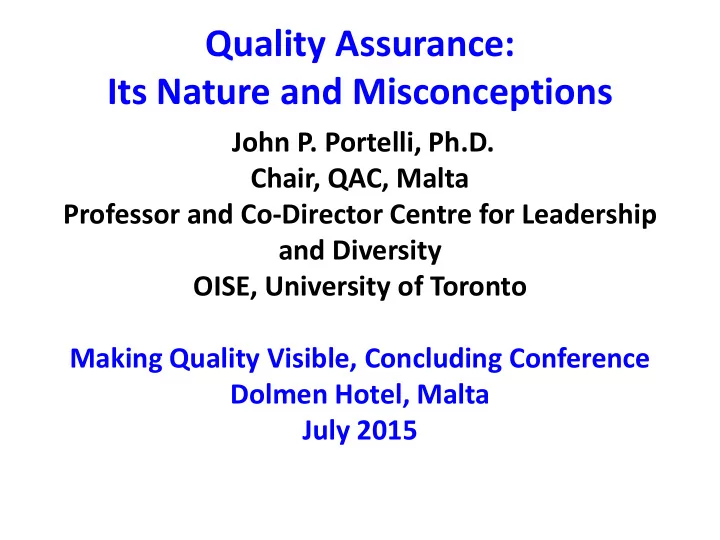

Quality Assurance: Its Nature and Misconceptions John P. Portelli, Ph.D. Chair, QAC, Malta Professor and Co-Director Centre for Leadership and Diversity OISE, University of Toronto Making Quality Visible, Concluding Conference Dolmen Hotel, Malta July 2015
Myths • Schooling and education are identical • Q.A. is a matter of policing and controlling • Quality is a fixed, monolithic entity; not flexible • One size fits all: marginalization and exclusion • If we have Q.A. procedures in place then quality is assured. • Context does not matter; Q.A. is an abstraction
QUALITY ASSURANCE MONITORING
Success Relational term Meaning depends on the aims and criteria used to determine whether success has been reached Example from literacy
To determine success we need to focus on 3 aspects: Aims/criteria: what values/norms are used to determine success? Performance: does the students' performance match the aims? Opportunities to learn: What support do the students get?
• Different and competing notions of success – Academic success – Public achievement success – What counts as a “ frill ” and “ distraction ” ? • Democratic perspective allows/demands a variety of notions of success to operate at the same time rather than an insistence on one set of standards (one size fits all) • A narrow notion of success yields a narrow notion and practice of engagement
Quality Assurance: Definition The maintenance of a desired level of quality in a service or product especially by means of attention to every stage of the process of delivery or product.
Reflective questions • What do you mean by quality? • Why do you strive to achieve quality?
Quality: Different meanings • Being Exceptional (beyond minimum standards) • Consistency • Fitness for purpose • Value for money • Transformative (qualitatively or quantitatively? )
Quality Assurance vs. Quality Control • Quality Assurance : the act of giving confidence; the planned and systematic activities implemented in a quality system • Quality Control: An evaluation to indicate needed corrective responses; the observation techniques and activities used to fulfill requirements for quality
The following may be recorded for quality assurance purposes
Development of Q.A. and Q.C. • Pre-1900: Integral part of craftsmanship • 1900-1920: Foreman: Q.C. • 1920-1940: Inspectors: Q.C. • 1940-1960: Statistical process control • 1960-1980: Total Q.C. • 1980-1990: Total quality management • 1990 – present: CULUTRE OF CONTINUOUS IMPROVEMENT, ORGANIZATION WIDE
What is Q.A.? A general or overall management system of all aspects of an organization (University or Higher Education Institution): • Governance • Human Resources • Administrative • Teaching and Learning • Research and Dissemination • Facilities • Supports (Library, I.T., secretaries etc)
Quality Assurance • A framework in order to have standard operating procedures (S.O.Ps.) that cover all activities in an organization, and that reflect best practice in the field of that organization. • Hence the need and necessity of a Q.A. Manual that details the S.O.Ps. of the organization
What is needed for a proper Q.A. • Detailing the procedures • Audit: to ensure that procedures are followed • Documentation of audit; annual reports • Evaluation of actions documented • Internal evaluation (continuous) • External evaluation (periodically) • Importance of a Central Office of Q.A. as a centre of document collection and control.
Complete the Loop Phenomenon • Mission and vision, aims and objectives • What are we doing to achieve above? • Develop policy and procedures • Auditing and documenting • Annual reports: faculty, departments, university or higher education institituion • Evaluation: Internal and external THIS IS A CONTINUOUS PROCESS: GROWTH
Quality Assurance • Part of the ongoing reflective practice and planning • Collaborative • Helps us identify who we are, what we are doing, and where we want to go • Helps us identify needs and priorities • Take concrete action: short term and long term
45 meters of rope and you are finding fault with this little bit?
Myths • Schooling and education are identical • Quality is a fixed, monolithic entity • One size fits all: marginalization and exclusion • If we have Q.A. procedures in place then quality is assured. • Context does not matter; Q.A. is an abstraction
Fairness is NOT the same as one size fits all
Fairness A condition or state of inclusive, and respectful treatment of all people. Fairness does not mean treating people the same without regard for individual differences
THANK YOU www. john-peter-portelli.com
Recommend
More recommend